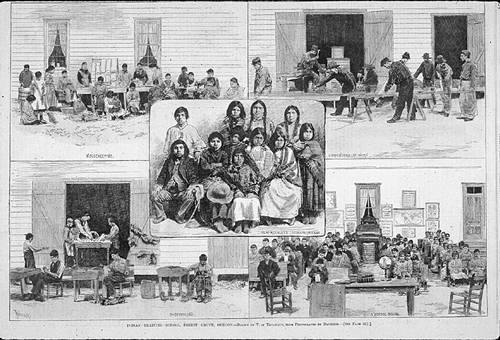Indian Schools in Oregon

Indian Schools in Oregon
FOREST GROVE, near Portland, Oregon, is the site of an Indian training school, where some very interesting and valuable educational work is going on. The institution is under the superintendence of Captain M. C. WILKINSON, U.S.A., to whose zeal, patience, and tact its success is entirely due. Like all thinking men who have been brought into relations with the aborigines of this continent, Captain WILKINSON has devoted much reflection to what is called the Indian question. He believes that the real solution of the problem lies in the systematic education of the rising generation. He is no advocate of that system of bribery and terror which has so long prevailed on the frontier, but asserts that the Indian tribal relations must be broken up as incompatible with our social organization, and that no adult member of any tribe be kept as a ward of the government. Let the adults provide for themselves, as the rest of us have to do. But in the case of the children Captain WILKINSON justly holds that the government can with benefit to all parties expend its money in their education and training. They ought to be taught various trades and handicrafts, so that when they return to their homes they may be properly fitted for life's struggles, and will infuse new ambitions into future generations, and be missionaries of the higher life of order, labor, and civilization.
In the training school at Forest Grove one hundred young Indians between the ages of five and twenty are kept, well fed, well clothed, and happy, and, as far as can be judged from appearances, quite as intelligent as a similar number of white youths. They came to the school from the prairies and the mountains, dressed in blankets and moccasins, with uncut and unkempt hair, as wild as young coyotes. They have already learned to sing like nightingales and work like beavers. It is remarkable that these young children of the forest are perfectly amenable to discipline, and never break a rule. The boys learn how to make boots and shoes, build houses, shoe horses, and how to perform various operations of agriculture. The girls learn to sew, darn, wash, cook, churn, iron, wash dishes, and keep their rooms in order. Both sexes learn their lessons promptly, and retain what they learn tenaciously. The common school games and amusements, playing ball, running races, and the like, are indulged in by the boys, while the little girls play with their dolls. They attend religious meetings and lectures, and sing and pray. The singing, indeed, is of remarkable excellence.
Captain WILKINSON last fall conducted his dusky pupils on a visit to Portland to attend the Young Men's Christian Association meeting, and the sight of these young red-skins excited general admiration. Captain WILKINSON gave some details of the organization to the school. The United States government for the first year appropriated only $5000 for him to start a school of twenty-five pupils, furnish transportation for them, teach, board, and house them. The boys built the houses themselves, the government only furnishing the materials. The four acres assigned to the institution were cultivated by the boys, who grubbed up the stumps, and planted potatoes and vegetables for their table. The school is thus partly self-supporting. The boys are attired in a regular uniform, and have their regular officers, as in our military schools. Every advantage placed in their way is eagerly seized on by these pupils, and it is worthy of notice by those who talk of the incorrigible character of the Indians that the parents, many of them chiefs, willingly and thankfully surrendered their sons and daughters in order that they might be taught the arts and learning of the white man.
All this work has been done in the space of two years, and a clear proof of the results attained was given in a local exhibition. Coarse leather shoes of first-class workmanship were displayed, the work of boys between fourteen and twenty. A handsome wash-stand and bureau were exhibited by another Indian, and some miniature oars and ladders by a young Alaskan ten years old. An exhibit of articles from the blacksmith shop also attracted attention. The amount of work accomplished by Captain WILKINSON and his Indian boys and girls is surprising. The buildings are commodious and comfortable; the matron, Mrs. BUCK, is a highly efficient head of this great home, and is ably seconded by three lady teachers.
We agree with Captain WILKINSON that this is the best solution of the difficulty which confronts us in our dealings with the Indians. The present race, demoralized by our vacillating and inconsistent Indian policy, may perhaps deserve the reputation of being incorrigible; let us then take the rising generation away from the evil influences which have surrounded their progenitors, and train them up to be useful and orderly members of society.
Transcribed verbatim from Harpers Weekly, Volume 26 (No. 1327), May 27, 1882
Text: p. 327, Illustration p.324
